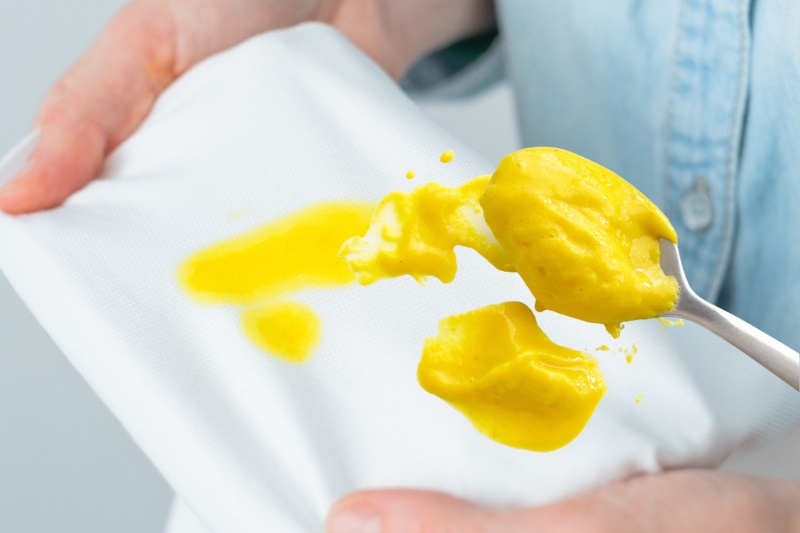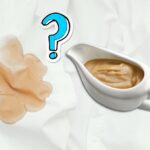Mustard, the delightful addition to burgers and hot dogs, can be an absolute nuisance when it comes into contact with clothes, carpets and furniture!
This pesky yellow condiment ranks high among the most challenging stains to tackle.
Its stubbornness is primarily due to its key ingredients being turmeric, an ingredient known for leaving persistent yellow marks on fabric surfaces, and mustard seeds, notorious for their dying properties.
Combine these elements, and you’re faced with a striking yellow blotch in the centre of your outfit, rug or sofa.
The best thing you can do is react quickly and remove the mustard stain. A fast response will improve your chances of removing the blemish in its entirety. Follow the steps below.
Tips to Keep in Mind When Tackling Mustard Stains
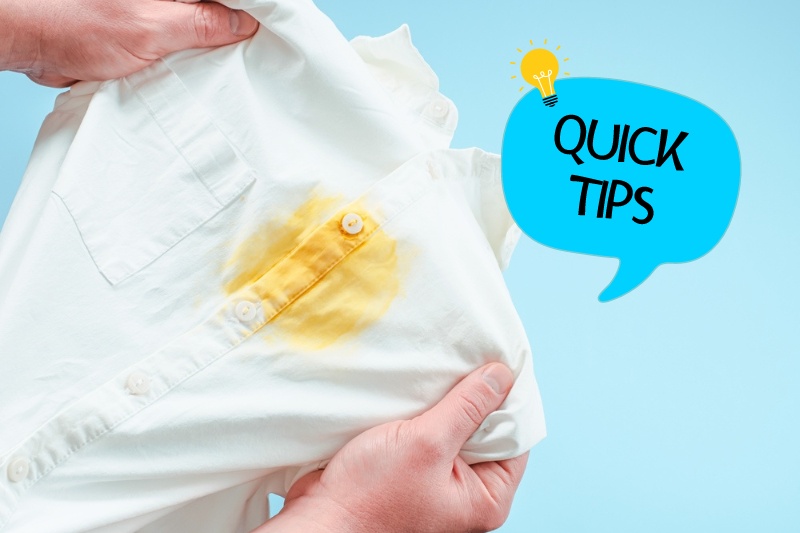
- Act fast! Don’t allow the stain to set in and age; treat it immediately. Old stains can be trickier to remove. In the worst case, a mustard stain may become permanent if left untreated for too long.
- Keep the stain contained in one area. Don’t spread the condiment around, and make more work for yourself!
- Don’t scrub the stain. Scrubbing drives the mustard deeper into the material’s fibres. Consequently, the blemish becomes more challenging to remove.
- Always do a patch test with your chosen cleaning solution before you use it. If there isn’t a reaction between the material and the solution, continue using it. Stop immediately if you see a problem.
- If the care label on your item of clothing/carpet/furniture says ‘Dry Clean Only’, stick to this advice. It is possible to buy a DIY kit and clean your item at home, but this can be tricky and doesn’t always work out for the best.
- Don’t dry your item until you know it’s free from mustard. Heat sets stains! In turn, they become problematic and sometimes impossible to remove.
How to Remove Fresh Mustard Stains from Clothes

Tools you need:
- Cold water
- Neutral-coloured cloths
- Biological laundry detergent
- Optional: Colour-safe bleach
- Optional: White vinegar
- Cup
- Stain remover
- Teaspoon
Steps to follow:
- Gently scrape off the excess mustard with a teaspoon.
- Run cold water through the back of the mustard stain – hold the item under running water for several minutes.
- Blot biological laundry detergent into the mustard stain using a neutral-coloured cloth.
- Wait 15 minutes.
- Run cold water through the back of the mustard stain.
- If the mustard stain is still present, pop a stain remover on the blemish – something like Dr. Beckmann’s Stain Devils Fat & Sauces.
- Wait the time stipulated on the stain remover’s packaging.
- Launder the garment as usual. Use cold water and add a dose of biological detergent.
- Optional: Add a small amount of colour-safe bleach or a cup of white vinegar to the machine to remove the lasting yellow bits from your item.
- Repeat the steps above if the yellow blemish is still on your item of clothing.
- Dry your garment when the mustard stain has been completely removed.
If you don’t want to use colour-safe bleach in the washing machine, you can dilute a dose of it in a bucket of cold water and soak your mustard-stained item in the water for a set amount of time (see instructions on the packaging).
Tip: If you’re out and about, you won’t be able to take your mustard-stained clothes off to treat them. So, have a backup plan in place! Keep some wipes, like these M&S Stain Removing Wipes, in your bag/car so you can quickly wipe and gently ‘treat’ the mustard marks on your outfit. You can then treat the items properly when you get home.

Delicate materials
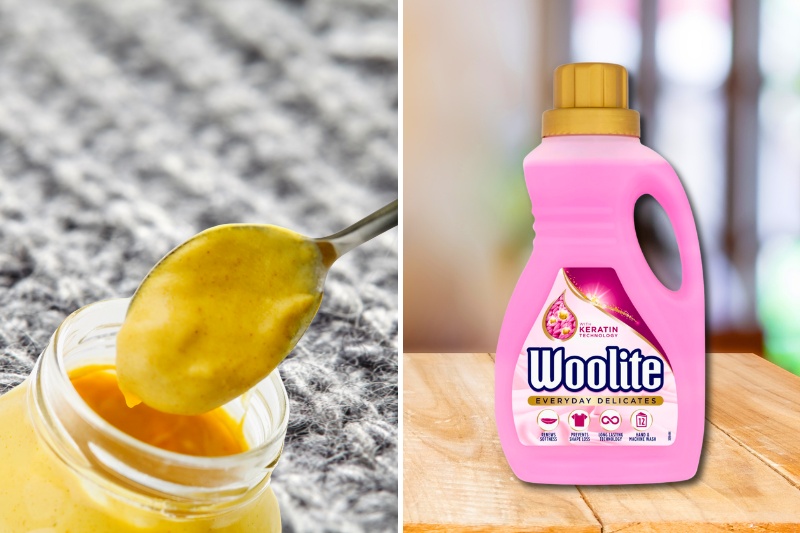
When it comes to treating delicate materials, you’ve got to treat them item using a laundry detergent that suits the material.
For example, choose a cleaner like Woolite if you’re treating silk and wool. ‘Normal’ or biological detergents are often too strong for such materials and can ruin them.
In addition, you can’t bleach delicate garments, as they will not be able to withstand the effects.
Treat these items with white vinegar instead. Simply blot a small amount of diluted white vinegar onto the stain, wait a few minutes, and then flush cold water through the back of the blemish. You can then launder the item of clothing.
Make sure you do a discreet patch test with your chosen cleaning solution before treating a delicate item. A small test could save you from ruining your entire outfit.
Of course, if you don’t feel comfortable cleaning mustard off a delicate item of clothing, you can always take it to a dry cleaning store. You can find a suitable dry cleaner by doing an online search. Just pick someone who has a good reputation and lots of positive reviews.
How to Remove Old Mustard Stains from Clothes

It’s not always possible to treat a mustard stain immediately, so it ages and dries out. Here’s how you clean an aged mustard mark:
Tools you need:
- Cold water
- White cloths
- Biological laundry detergent
- Optional: Colour-safe bleach
- Optional: White vinegar
- Stain remover like Beckmann’s Stain Devils Fat & Sauces
- Teaspoon or credit card
- Cup
Steps to follow:
- Gently scrape off the dried mustard using a teaspoon or an old credit card. Be careful you don’t want to damage the material’s fibres.
- Run cold water through the back of the mustard stain to flush it out.
- Apply a biological detergent to the mustard blemish using a white cloth.
- Wait an hour.
- Launder the item of clothing using cold water and detergent.
- Assess the garment after the wash.
- Re-treat the item again, or continue with the steps below.
- Apply a stain remover to the front and back of the mustard stain.
- Wait the time stipulated on the stain remover’s packaging.
- Launder the item of clothing using cold water and detergent.
- Optional: Add a small amount of colour-safe bleach or a cup of white vinegar to the machine to remove the lasting yellow bits from your item.
- Assess the garment after the wash.
- Re-treat the item.
- Dry the garment when the entire yellow mustard stain has gone.
How to Remove Mustard Stains from Carpets
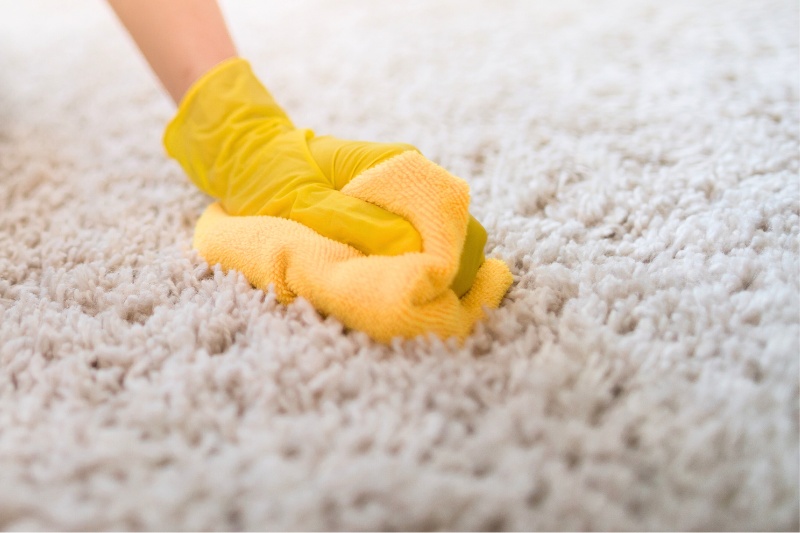
If you’ve got a blob of mustard on your carpet, don’t fret.
Follow the steps below to remove the yellow eyesore from the surface:
- Use a teaspoon to remove as much mustard as possible from the carpeted surface. If the mustard is dry, carefully scrape the mustard off using a blunt knife or nit comb (head lice).
- Mix one tablespoon of washing-up liquid, two cups of cold water, and a tablespoon of white vinegar in a bowl.
- Stir.
- Dip a neutral-coloured cloth into the liquid.
- Blot the mustard stain with the damp cloth.
- Continuously blot the carpet until the stain is gone. Use a new patch of cloth each time you blot so you don’t reapply the mustard.
- Blot the carpet with a fresh, damp cloth just soaked in cold water.
- Allow the carpet to air dry if the yellow blemish has gone. Open the window and point a fan towards the treated spot to speed up the drying process.
- Repeat the steps above if the yellow blemish is still present.
- If you’re having trouble, you can turn to an off-the-shelf carpet cleaner for help. Consider using Dr. Beckmann’s Carpet Stain Remover or White Wizard. If you need more help, contact a professional carpet cleaner.
Remember:
- Always do a patch test with your chosen cleaning solution.
- Stick to the manufacturer’s instructions.
- Remove any excess product from the surface using a damp, white cloth.
- Don’t oversaturate your carpet in liquid because it’ll take ages to dry.
- Keep kids and pets away from the area when treating/allowing it to dry.
- You will likely have to repeat the step above multiple times. Mustard is a tough stain, and removing it can be troublesome!
How to Remove Mustard Stains from Upholstery
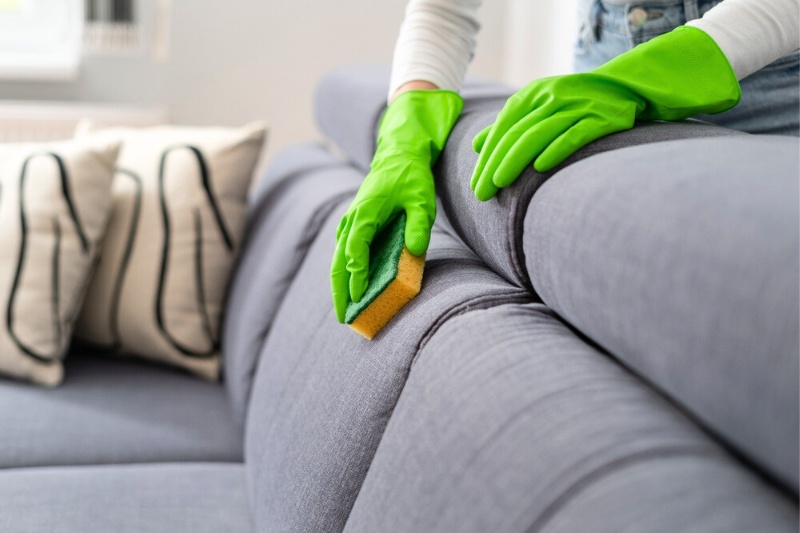
Accidentally dropped mustard on the sofa? To remove it, follow the steps above under ‘How to Remove Mustard Stains from Carpets’. A fast response from you is vital – so don’t wait around; go and treat that mustardy eyesore right now!
However, if you want to use an off-the-shelf stain remover, use Dr Beckmann’s Upholstery Stain Remover official upholstery cleaner instead of the carpet version mentioned above. The upholstery cleaner comes with a different shaped head, making it better at cleaning settees and chairs.
Don’t saturate the upholstery, as it will take ages to dry! Stick to using damp cloths and soak up excess liquids immediately
If your furniture is badly damaged, consider calling an upholstery specialist to assess the damage(s) and to see if it can be repaired.
Are Mustard Stains Permanent?
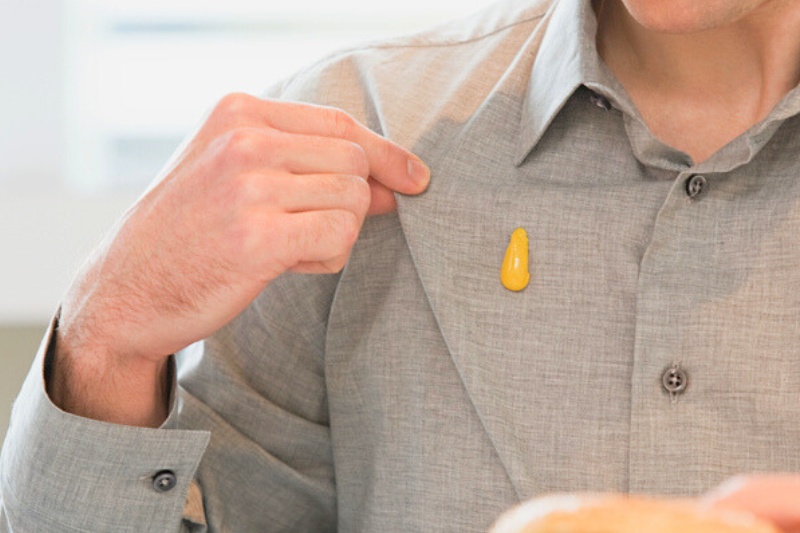
If you’ve completed the steps above multiple times and you’re still left with a yellow blemish on your item, you can assume that the mustard stain is permanent.
You can, of course, ask a dry cleaner or specialist cleaner for more help. However, you should brace yourself for the worst.

Bethan has a passion for exploring, reading, cooking and gardening! When she’s not creating culinary delights for her family, she’s concocting potions to keep her house clean!
